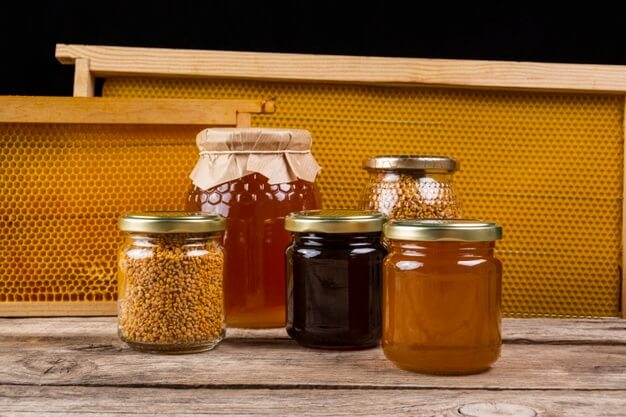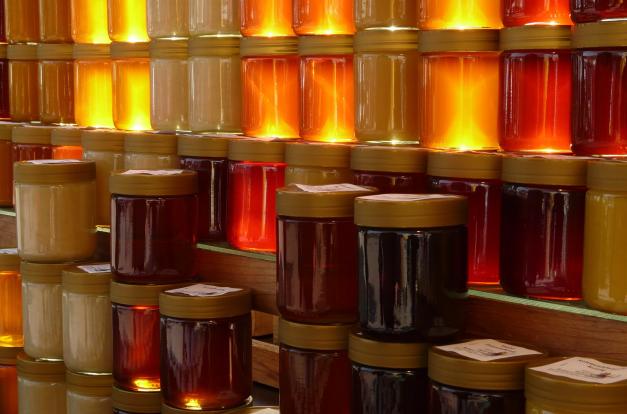There are many notions about honey. Plenty of people think it lasts forever. Plenty opine it only stores well for a decade or so. And then there’s the case of the “best before” labels on packaged honey. So, which is it? Does honey go bad or expire, or can it actually last indefinitely? Let’s find out.
What is the shelf life of honey?
The true shelf life of honey depends on how it’s stored. Sealed jars of honey recovered from ancient Egyptian tombs have been found to be good for consumption. And these have been stored away for thousands of years. Researchers believe that natural honey preserved in air-tight containers can last for centuries.
Fresh, raw honey exists as a semi-solid supersaturated solution. The sugar-water mix contains more sugar than can be typically dissolved in water at room temperature.
The bees’ salivary glands contain an enzyme known as invertase which helps create hydrogen peroxide and gluconic acid. These substances suppress the growth of bacteria and make honey acidic, giving it a long shelf-life.
But what about adulterated or fake honey – does it share natural honey’s longevity? Commercially sold honey can contain these adulterants:
- Cane sugar syrup
- Corn sugar syrup
- High fructose corn syrup
- Maize syrup
- Flour
- Water
- Banana
The presence of these adulterants doesn’t just impact honey’s taste, nutritional value and shelf life. The consumption of adulterated honey can also cause the following health issues:
- Obesity
- High blood pressure
- Increase in blood lipid level
- Fatty liver
- Kidney injury
- Death
Fake honey is mostly caramelized sucrose which has none of the natural honey’s nutritional benefits. It may also contain additional preservatives. Its shelf life, however, is still shorter than natural honey.

How can you tell fake honey apart from pure honey?
When it comes to honey purity, the label itself is not any real help. The US government doesn’t have any strict laws regarding testing honey for purity. Even the USDA (United States Department of Agriculture) logo doesn’t guarantee the honey is pure, natural or without additives.
Only Florida’s state laws dictate that the label on honey display a list of all the additives used. This applies to all honey sold and manufactured within the state borders.
Note that products that are marketed under a name other than “honey” are exempt from this regulation. An item labeled “honey blend”, for instance, isn’t required to list all the additives on the label.
It’s also not uncommon for vendors to lie on the label. Luckily there are some easy honey testing methods you can try.
- Warm water test
Take a spoonful of honey from the jar and add it to a glassful of warm water. You may stir gently or simply let the honey sit in. If the honey contains any sugar syrups, it will soon dissolve. Pure honey, on the other hand, will sink to the glass’ bottom and remain there as a lump.
Adulterated honey that’s sold in solid honeycomb, crystallized or creamed form dissolves with difficulty. This test, therefore, is never 100 percent reliable.
- Fire test
Dip a candle wick or small cotton pad in honey. Then set it alight. If the honey contains added water, it may produce a cracking noise and resist burning. If the honey is unadulterated, the wick or pad will readily catch fire.
- Blotting paper test
Put a drop of honey on a blotting paper. Honey that contains added water may get absorbed leaving a wet mark on the blotting paper.
Pure honey, on the other hand, doesn’t get absorbed by absorbent surfaces such as blotting paper or paper towel.
Popular but useless tests for checking honey purity
The following honey purity tests are all but myths. But these have been prevalent for so long, you may have come to trust them like so many others.
- Mixing honey and alcohol
It’s wrongly believed that adulterated honey dissolves when mixed with alcohol and turns the solution milky. According to this theory, pure honey doesn’t dissolve in alcohol but settles down at the bottom. The inverse is also believed by many to be a reliable test for honey’s purity.
Don’t put your faith in either notion.
- The shape or movement of honey
Many believe that pure honey will always turn in the clockwise direction when it’s poured. Another popular theory is that pure honey will assume a hexagonal form when placed on a plate that’s covered by water. There are no scientific merits to these theories.
Tips to increase your chances of buying pure honey
- Well-known brands have plenty to lose if they’re found to be lying about the purity of their honey. Make sure to read the users’ reviews.
- Prefer honey being sold at your local farmers market or by beekeepers from your area. This is more likely to be pure than honey from random online sources.
- Honeycombs have a high probability of being pure. Look for vendors who sell honeycombs straight from the beehives.
- Prefer buying honey that’s in granulated or crystallized form over honey in other forms. Granulated or crystallized honey has been found to be pure more often than honey being sold in liquid or semi-solid forms.
Read here: How is honey made
What are the signs that honey has gone bad?
Spoiled honey typically shows one or more of these signs:
- It will lose its clear golden hue and take on a cloudy yellow tint instead.
- It will develop a grainy texture.
- Completely spoiled honey is extremely hard and has a white tone.
- Honey stored up for an extended period can grow dark; lose its taste and aroma. While it’s still safe for consumption, doing so won’t be a very pleasant experience.
What causes honey to go bad?
There are four main reasons honey can go bad. These are:
- Contamination
Raw honey often contains microbes such as mold, bacteria, and yeast. Dust, pollen air and the bees’ own digestive tracts can cause these microbes to contaminate honey. Honey’s inherent microbial properties prevent most of these microbes from becoming a health risk.
The one naturally occurring microbe that can cause serious health problems is C. botulinum. This neurotoxin is mostly non-threatening for adults. It can, however, cause respiratory distress, paralysis and nervous issues to babies aged one or under.
Pediatricians strictly advise against feeding honey to babies falling in that age bracket.
Processing honey in unhygienic conditions can also contaminate the final packed product, causing it to go bad prematurely.
- Adulteration
Unscrupulous businesses look to reduce the time and costs of production by harvesting all the honey produced by the bees. The bees end up being fed with high fructose corn syrup or cheap refined sugar syrups. This has been found to be detrimental to the bees’ health and their honey’s quality.
Another big issue with feeding bees with artificial sugar syrup is that they end up feeding too close to one another. In nature, bees seldom feed in close proximity to each other. Doing so can cause transmission of diseases among the bees, in turn, affecting the honey’s quality.
- Crystallization
Is crystallized honey bad? It can be, if allowed to crystallize for a long period of time. Prolonged crystallization promotes fermentation which alters the honey’s appearance and taste. It will take on a whitish, opaque look and lose its original sweetness.
- Improper storage
Improper storage can impact honey’s antimicrobial properties, reducing its shelf life. Being exposed to sunlight or humid air can increase honey’s water content. This results in promoting the growth of microbes.
How to store honey to maximize its shelf life?
Keeping honey safe for consumption for long periods of time isn’t a tough task. Just follow these few simple guidelines:
Use a sealed container for storage
The container that the honey originally came in is usually ideal for storage. Simply close the lid tightly after each use and avoid using a wet spoon for extracting honey.
Glass jars with airtight lids are also great for storing honey. Avoid containers made of metals or non-food grade plastic. These can promote oxidation and cause the honey to spoil.
Store honey containers at room temperature
Room temperature (64-75 degrees Fahrenheit) is the perfect temperature range for storing honey. Place the packaged honey away from direct sun or sources of heat.
Don’t refrigerate honey
Does refrigerated honey go bad? Not exactly. Refrigeration, however, causes honey to acquire a semi-solid state which can make it harder to extract and consume. It’s hence advisable not to refrigerate honey.

Can you salvage honey that’s started to spoil?
In some cases, such as crystallization or granulation, you can reverse the unwanted changes to honey. Honey that’s begun to crystallize, lost its sweetness and liquid form can be restored to its original taste and form.
Here are some easy ways to de-crystallize honey:
- Remove the honey container’s lid, and then place the container in a pot. Next, add warm water (temperature not exceeding 110 degrees Fahrenheit) to the pot. Let the container sit inside the pot until the honey has melted.
- After 5 minutes, remove the container from the pot and gently stir the honey for a few minutes. Then return the container to the warm water of the pot. Repeat this process until the honey has regained its original liquid form.
- Remove the container from the pot and allow the honey to cool down. Then seal the container and store it away at room temperature at a safe, dry spot.
Frequently asked questions about honey
- What are the most important honey benefits?
Answer: Raw honey is a rich source of plant chemicals that function as potent antioxidants. The antioxidants found in honey have been known to be effective in preventing cellular damage, heart disorders, and cancer.
Regular consumption of honey can also boost immunity and cure stomach ulcers, suppress cough and soothe sore throat.
- Does honey go bad if heated?
Answer: It does. It’s safe to have honey in lukewarm water or milk. It shouldn’t however, be had in hot liquids, be cooked or heated to high temperatures. Honey heated to a temperature of 140 degrees Fahrenheit can turn toxic.
- Does freezing honey spoil it?
Answer: Freezing honey doesn’t impact its nutritional value. The only possible drawback of frozen honey lies in heating frozen honey repeatedly for consumption. Subjecting honey to fluctuating temperatures can cause crystallization and add to its moisture content.
You can get past this issue by thawing the frozen honey all at once.
- Can eating raw honey make you sick?
Answer: Raw unfiltered honey does carry certain health risks. Foraging bees often gather nectar from poisonous plants. They also feed on honeydew – a sticky, high-sugar liquid excreted by aphids and other insects. This can cause honey to have a high concentration of grayanotoxin and other naturally occurring neurotoxins.
Consumption of such honey can cause Mad Honey Poisoning – a condition that can lead to dizziness, nausea, vomiting, weakness, excessive salivation and perspiration. In severe cases, it can cause paresthesia, lower the blood pressure, even cause death.
Raw honey can contain fine particles of pollen. Its consumption can cause allergic reactions in individuals who’re allergic to pollen. The most common symptom is irritation in the oral mucosa. In severe cases, a person can suffer from an anaphylactic shock.
Individuals susceptible to seasonal environmental allergies such as hay fever are advised to avoid consuming raw honey.
- Does honey go bad after the expiration date?
Answer: Commercially sold honey typically comes with a “best before 2 years of packaging” advisory. That doesn’t necessarily mean it spoils after the date of expiry. The honey’s taste, aroma and density are indicative of whether or not it’s good for consumption.
Follow the honey storage tips mentioned in this article and you can continue to enjoy honey’s awesome taste and nutritional benefits for years past the expiration date.
Read here more:-